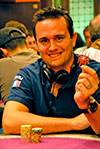Announced bets
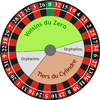
Announced bets or „Call Bets”, as they are on a regular basis referred to by the players, are wagers where the gamer calls a bet and immediately places the amount of money necessary to cover it on the table, before the croupier announces the stop.
The roulette wheel, as you know, has 37 or 38 pockets with numbers ranging from 0 and 00 to 37 that are arranged in five different series. Bets on one or more of these series are also called „French Bets”.
French bets
This series is composed by the seventeen numbers, placed on the wheel between 22 and 25 including both 22 and 25. On the European wheel, the series is: 22, 18, 29, 7, 28, 12, 35, 3, 26, 0, 32, 15, 19, 4, 21, 2, 25.
9 chips or multiples of 9 must be placed on the table layout to cover this bet:
1 chip is placed on the split: 32/55
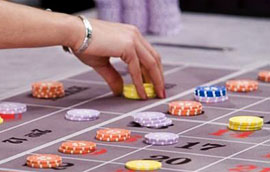
Zero Game (Jeu zéro in French)
This is a kind of bet where you wager on the numbers closest to zero.
The numbers are as follows:
12, 35, 3, 26, 0, 32, 15.
4 chips or multiples of 4 must be placed on the table layout to cover this bet: 1 chip placed straight up on 26
1 chip on the split 32/35
1 chip on the split 12/15
1 chip on the split 0/3
There is also another type of Zero Game bet, with 5 chips placed on the layout; the fifth chip is placed straight up on 19.
Thirds of the Wheel (Le tiers du cylindre in French)
The Tiers bet, as it is on a regular basis referred to by the players, is a bet made on the twelve numbers situated between 27 and 33, including both 27 and 33. The series is as follows: 27, 13, 36, 11, 30, 8, 23, 10, 5, 24, 16, 33.
6 chips or multiples of 6 should be placed on the table layout to cover the bet:
1 chip placed on the split 5/8
1 chip placed on the split 10/11
1 chip placed on the split 13/16
1 chip placed on the split 23/24
1 chip placed on the split 27/30
1 chip placed on the split 33/36
There is also another type of Thirds of the Wheel bet, with 10 chips placed on the layout and an additional bet of 1 chip straight up on 5, 8, 10 and 11; this one is called „Tier 5, 8, 10, 11”.
Orphans (Orphelins)
The Orphans bet is called on an eight-number series, being placed on the two slices of the wheel on the outside of Voisins and Tiers. The series is as follows: 17, 34, 6 and 1, 20, 14, 31, 9.
5 chips or multiples of 5 chips must be placed on the table layout, as follows:
1 chip is placed straight up on 1
1 chip is placed on the split 6/9
1 chip is placed on the split 14/17
1 chip is placed on the split 17/20
1 chip is placed on the split 31/34
The Neighbors
Using this type of Called bet, you can back up a certain number using the two numerals that are placed on either side of it on the wheel. As an example, we will use „0 and the Neighbors”. This is a 5 or multiples of 5 chips placed as follows:
1 chip is placed straight up on 3
1 chip is placed straight up on 26
1 chip is placed straight up on 0
1 chip is placed straight up on 32
1 chip is placed straight up on 15
15 or multiples of 15 chips must be placed on the table layout to cover this bet, as follows:
1 chip is placed straight up on 18
1 chip is placed straight up on 22
1 chip is placed straight up on 33
1 chip is placed straight up on 16
2 chips are placed straight up on 9
2 chips are placed straight up on 31
2 chips are placed straight up on 20
2 chips are placed straight up on 1
3 chips are placed straight up on 14
You can see the Fibonacci system in action
Final bets
This is another type that you can use at the roulette table. The best way to explain such bets is by using examples:
Final 4 is a 4 or multiples of 4 chips bet on all the numbers ending in 4 on the table layout as follows:
1 chip is placed straight up on 4
1 chip is placed straight up on 14
1 chip is placed straight up on 24
1 chip is placed straight up on 34
Final 7 is a 3 or multiples of 3 chips bet on all the numbers ending in 7 on the table layout, as follows:
1 chip is placed straight up on 7
1 chip is placed straight up on 17
1 chip is placed straight up on 27
Final bets starting from zero to 6 will cost you 4 chips or a multiple of 4, while the last three final bets (7, 8 and 9) will cost you 3 chips or a multiple of 3.
Full completes/maximum bets
Maximum bets are a type preferred by the high rollers – it refers to placing all the inside bets on a certain number.
This maximum amount can be easily calculated using a progressive betting model. But the best way to demonstrate this is to use an example:
Let’s say that the maximum amount allowed to be wagered on a straight up bet is $1000. Then, the maximum wager on a split bet will be $2000; each one corner containing your number of choice will have a maximum wager amount of $4000. On every street you will be able to bet a maximum of $3000 and each six line containing your number will allow a maximum wager of $6000. When we add everything up, you will see that in fact the wager is $40.000 on a Maximum Bet.
We will go even further with the example and designate our number of choice to be 17; in order to make a maximum bet you will require to lay 40 chips on the table, placed as follows:
1 chip is placed straight up on 17
2 chips are placed on the split 17/14
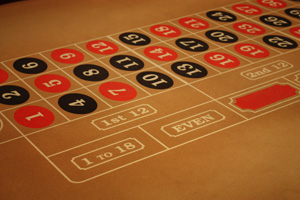
2 chips are placed on the split 17/16
2 chips are placed on the split 17/18
2 chips are placed on the split 17/20
3 chips are placed on the street 17/16/18
4 chips are placed on the corner 17/16/13/14
4 chips are placed on the corner 17/18/14/15
4 chips are placed on the corner 17/16/19/20
4 chips are placed on the corner 17/18/20/21
6 chips are placed on the six line 17/16/18/13/14/15/6
6 chips are placed on the six line 17/16/18/19/20/21/6
This bet will pay out 392 chips if number 17 comes up: in the case of the example I just gave you, the player wagered 40 chips, each valued at $1000 and won 392 chips, each valued at $1000. If you follow this progressive betting model, you can determine the number of chops necessary to make a maximum bet for all the numbers on the wheel:
Zero will cost you 17 chips to complete and will pay 235 chips.
Numbers 1 and 3 each will cost 27 chips and pay 297 chips.
Number 2 will cost 36 chips and pay 396 chips.
The 1st column will cost you 30 chips for each number and pay 294 chips/number.
The 2nd column will cost you 40 chips for each number and pay 392 chips/number.
Numbers 34 and 36 each cost 18 pieces and pay 198 pieces.
Number 35 is a 24-piece bet which pays 264 pieces.
However, one chip can be worth anywhere from $1 to $1000: going back to our example we remember that if you choose number 17 to bet on, you will have to lay 40 chips on the table and that will bring you a profit of 392 chips in case you win, but each chip can have a value between $1 and $1000.
Strategy & Tactics
Along the casino history, many players tried to turn the odds in their favor: most of them were using a system or a strategy and almost all were promoting the idea that any casino (even William Hill) can be beaten – all one had to do was observe a basic pattern in the wheel spin results, thus predicting the outcome of the future wheel spins.
Nearly all the systems and strategies are based on the idea that the outcome of a wheel spin is somehow related to the result of the one that preceded it. Nowadays, we know that all the betting systems based on patterns are destined to fail and the result can be no other than you losing money. These kinds of pattern systems have a very high risk rate, because they are wrong in assuming that the spin results are related in some way to one another.
Also, there were and still are some betting systems that work.


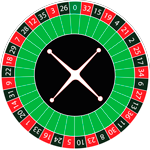




 888Casino
888Casino Ladbrokes
Ladbrokes NordiCasino
NordiCasino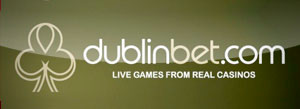 Dublinbet
Dublinbet